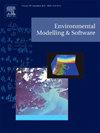Combining residual convolutional LSTM with attention mechanisms for spatiotemporal forest cover prediction
IF 4.8
2区 环境科学与生态学
Q1 COMPUTER SCIENCE, INTERDISCIPLINARY APPLICATIONS
引用次数: 0
Abstract
Understanding spatiotemporal variations in forest cover is crucial for effective forest resource management. However, existing models often lack accuracy in simultaneously capturing temporal continuity and spatial correlation. To address this challenge, we developed ResConvLSTM-Att, a novel hybrid model integrating residual neural networks, Convolutional Long Short-Term Memory (ConvLSTM) networks, and attention mechanisms. We evaluated ResConvLSTM-Att against four deep learning models: LSTM, combined convolutional neural network and LSTM (CNN-LSTM), ConvLSTM, and ResConvLSTM for spatiotemporal prediction of forest cover in Tasmania, Australia. ResConvLSTM-Att achieved outstanding prediction performance, with an average root mean square error (RMSE) of 6.9% coverage and an impressive average coefficient of determination of 0.965. Compared with LSTM, CNN-LSTM, ConvLSTM, and ResConvLSTM, ResConvLSTM-Att achieved RMSE reductions of 31.2%, 43.0%, 10.1%, and 6.5%, respectively. Additionally, we quantified the impacts of explanatory variables on forest cover dynamics. Our work demonstrated the effectiveness of ResConvLSTM-Att in spatiotemporal data modelling and prediction.
将残差卷积 LSTM 与注意力机制相结合,用于时空森林覆盖率预测
了解森林覆盖率的时空变化对于有效管理森林资源至关重要。然而,现有模型在同时捕捉时间连续性和空间相关性方面往往缺乏准确性。为了应对这一挑战,我们开发了 ResConvLSTM-Att,这是一种集成了残差神经网络、卷积长短期记忆(ConvLSTM)网络和注意力机制的新型混合模型。我们针对四种深度学习模型对 ResConvLSTM-Att 进行了评估:LSTM、卷积神经网络与 LSTM 的组合(CNN-LSTM)、ConvLSTM 和 ResConvLSTM,对澳大利亚塔斯马尼亚的森林覆盖率进行了时空预测。ResConvLSTM-Att 实现了出色的预测性能,平均均方根误差 (RMSE) 为覆盖率的 6.9%,平均判定系数为 0.965,令人印象深刻。与 LSTM、CNN-LSTM、ConvLSTM 和 ResConvLSTM 相比,ResConvLSTM-Att 的 RMSE 分别降低了 31.2%、43.0%、10.1% 和 6.5%。此外,我们还量化了解释变量对森林植被动态的影响。我们的工作证明了 ResConvLSTM-Att 在时空数据建模和预测方面的有效性。
本文章由计算机程序翻译,如有差异,请以英文原文为准。
求助全文
约1分钟内获得全文
求助全文
来源期刊

Environmental Modelling & Software
工程技术-工程:环境
CiteScore
9.30
自引率
8.20%
发文量
241
审稿时长
60 days
期刊介绍:
Environmental Modelling & Software publishes contributions, in the form of research articles, reviews and short communications, on recent advances in environmental modelling and/or software. The aim is to improve our capacity to represent, understand, predict or manage the behaviour of environmental systems at all practical scales, and to communicate those improvements to a wide scientific and professional audience.
 求助内容:
求助内容: 应助结果提醒方式:
应助结果提醒方式:


